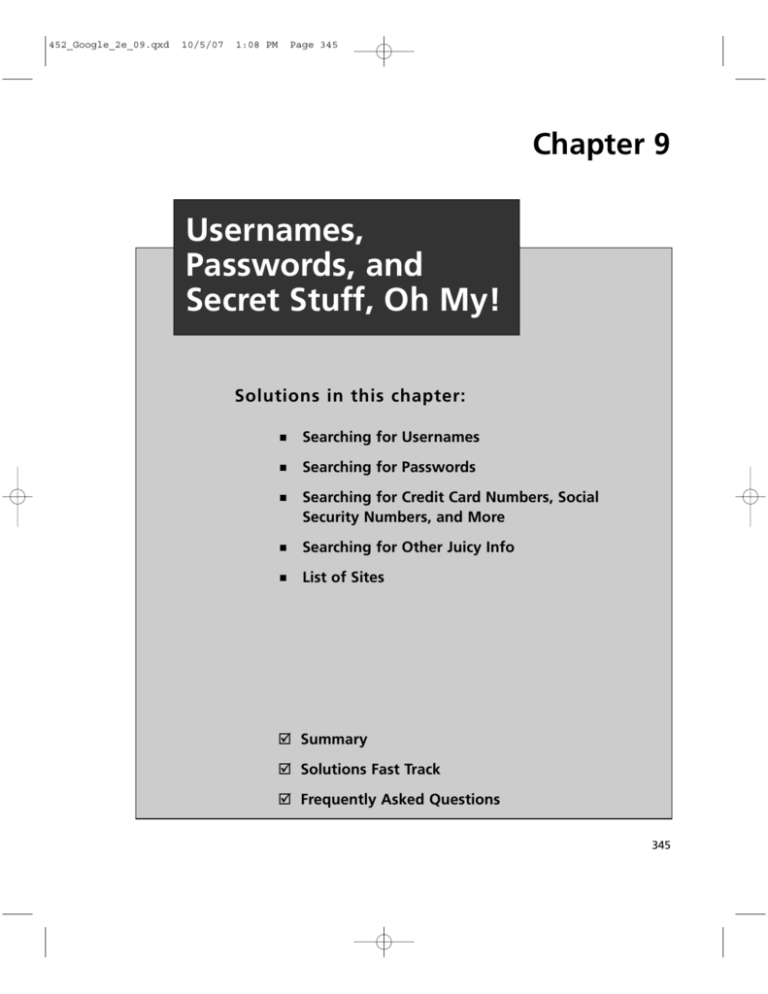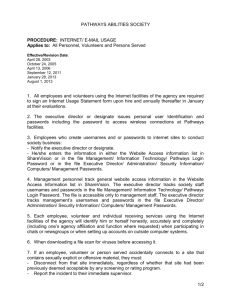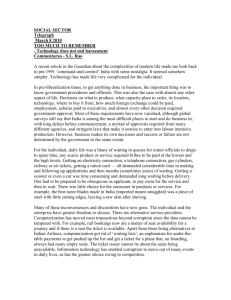Usernames, Passwords, and Security: Chapter 9
advertisement

452_Google_2e_09.qxd 10/5/07 1:08 PM Page 345 Chapter 9 Usernames, Passwords, and Secret Stuff, Oh My! Solutions in this chapter: ■ Searching for Usernames ■ Searching for Passwords ■ Searching for Credit Card Numbers, Social Security Numbers, and More ■ Searching for Other Juicy Info ■ List of Sites Summary Solutions Fast Track Frequently Asked Questions 345 452_Google_2e_09.qxd 346 10/5/07 1:08 PM Page 346 Chapter 9 • Usernames, Passwords, and Secret Stuff, Oh My! Introduction This chapter is not about finding sensitive data during an assessment as much as it is about what the “bad guys” might do to troll for the data.The examples presented in this chapter generally represent the lowest-hanging fruit on the security tree. Hackers target this information on a daily basis.To protect against this type of attacker, we need to be fairly candid about the worst-case possibilities. We won’t be overly candid, however. We don’t want to give the bad guys any ideas they don’t already have. We start by looking at some queries that can be used to uncover usernames, the less important half of most authentication systems.The value of a username is often overlooked, but as we’ve already discussed, an entire multimillion-dollar security system can be shattered through skillful crafting of even the smallest, most innocuous bit of information. Next, we will take a look at queries that are designed to uncover passwords. Some of the queries we look at reveal encrypted or encoded passwords, which will take a bit of work on the part of an attacker to use to his or her advantage. We also take a look at queries that can uncover cleartext passwords.These queries are some of the most dangerous in the hands of even the most novice attacker. What could make an attack easier than handing a username and cleartext password to an attacker? We wrap up this chapter by discussing the very real possibility of uncovering highly sensitive data such as credit card information and information used to commit identity theft, such as Social Security numbers. Our goal here is to explore ways of protecting against this very real threat.To that end, we don’t go into details about uncovering financial information and the like. If you’re a “dark side” hacker, you’ll need to figure these things out on your own, or make the wise decision to turn to the light side of the force. Searching for Usernames Most authentication mechanisms use a username and password to protect information.To get through the “front door” of this type of protection, you’ll need to determine usernames as well as passwords. Usernames also can be used for social engineering efforts, as we discussed earlier. Many methods can be used to determine usernames. In the “Database Digging” chapter, we explored ways of gathering usernames via database error messages. In the “Tracking Down Web Servers” chapter, we explored Web server and application error messages that can reveal various information, including usernames.These indirect methods of locating usernames are helpful, but an attacker could target a usernames directory with a simple query like “your username is”. This phrase can locate help pages that describe the username creation process, as shown in Figure 9.1. www.syngress.com 452_Google_2e_09.qxd 10/5/07 1:08 PM Page 347 Usernames, Passwords, and Secret Stuff, Oh My! • Chapter 9 347 Figure 9.1 Help Documents Can Reveal Username Creation Processes An attacker could use this information to postulate a username based on information gleaned from other sources, such as Google Groups posts or phone listings.The usernames could then be recycled into various other phases of the attack, such as a worm-based spam campaign or a social-engineering attempt. An attacker can gather usernames from a variety of sources, as shown in the sample queries listed in Table 9.1. Table 9.1 Sample Queries That Locate Usernames Query Description inurl:admin inurl:userlist inurl:admin filetype:asp inurl:userlist inurl:php inurl:hlstats intext: Server Username filetype:ctl inurl:haccess.ctl Basic Generic userlist files Generic userlist files Half-life statistics file, lists username and other information Microsoft FrontPage equivalent(?)of htaccess shows Web user credentials Microsoft Internet Account Manager can reveal usernames and more filetype:reg reg intext:”internet account manager” Continued www.syngress.com 452_Google_2e_09.qxd 348 10/5/07 1:08 PM Page 348 Chapter 9 • Usernames, Passwords, and Secret Stuff, Oh My! Table 9.1 continued Sample Queries That Locate Usernames Query filetype:wab wab Description Microsoft Outlook Express Mail address books filetype:mdb inurl:profiles Microsoft Access databases containing (user) profiles. index.of perform.ini mIRC IRC ini file can list IRC usernames and other information inurl:root.asp?acs=anon Outlook Mail Web Access directory can be used to discover usernames filetype:conf inurl:proftpd.conf –sample PROFTP FTP server configuration file reveals username and server information filetype:log username putty PUTTY SSH client logs can reveal usernames and server information filetype:rdp rdp Remote Desktop Connection files reveal user credentials intitle:index.of .bash_history UNIX bash shell history reveals commands typed at a bash command prompt; usernames are often typed as argument strings intitle:index.of .sh_history UNIX shell history reveals commands typed at a shell command prompt; usernames are often typed as argument strings “index of ” lck Various lock files list the user currently using a file +intext:webalizer +intext:Total Webalizer Web statistics page lists Web Usernames +intext:”Usage Statistics for” usernames and statistical information filetype:reg reg HKEY_CURRENT_ Windows Registry exports can reveal USER username usernames and other information www.syngress.com 452_Google_2e_09.qxd 10/5/07 1:08 PM Page 349 Usernames, Passwords, and Secret Stuff, Oh My! • Chapter 9 349 Underground Googling Searching for a Known Filename Remember that there are several ways to search for a known filename. One way relies on locating the file in a directory listing, like intitle:index.of install.log. Another, often better, method relies on the filetype operator, as in filetype:log inurl:install.log. Directory listings are not all that common. Google will crawl a link to a file in a directory listing, meaning that the filetype method will find both directory listing entries as well as files crawled in other ways. In some cases, usernames can be gathered from Web-based statistical programs that check Web activity.The Webalizer program shows all sorts of information about a Web server’s usage. Output files for the Webalizer program can be located with a query such as +intext:webalizer +intext:”Total Usernames” +intext:”Usage Statistics for”. Among the information displayed is the username that was used to connect to the Web server, as shown in Figure 9.2. In some cases, however, the usernames displayed are not valid or current, but the “Visits” column lists the number of times a user account was used during the capture period.This enables an attacker to easily determine which accounts are more likely to be valid. Figure 9.2 The Webalizer Output Page Lists Web Usernames www.syngress.com 452_Google_2e_09.qxd 350 10/5/07 1:08 PM Page 350 Chapter 9 • Usernames, Passwords, and Secret Stuff, Oh My! The Windows registry holds all sorts of authentication information, including usernames and passwords.Though it is unlikely (and fairly uncommon) to locate live, exported Windows registry files on the Web, at the time of this writing there are nearly 200 hits on the query filetype:reg HKEY_CURRENT_USER username, which locates Windows registry files that contain the word username and in some cases passwords, as shown in Figure 9.3. Figure 9.3 Generic Windows Registry Files Can Reveal Usernames and Passwords As any talented attacker or security person will tell you, it’s rare to get information served to you on a silver platter. Most decent finds take a bit of persistence, creativity, intelligence, and just a bit of good luck. For example, consider the Microsoft Outlook Web Access portal, which can be located with a query like inurl:root.asp?acs=anon. There are few hits for this query, even though there lots of sites run the Microsoft Web-based mail portal. Regardless of how you might locate a site running this e-mail gateway, it’s not uncommon for the site to host a public directory (denoted “Find Names,” by default), as shown in Figure 9.4. www.syngress.com 452_Google_2e_09.qxd 10/5/07 1:08 PM Page 351 Usernames, Passwords, and Secret Stuff, Oh My! • Chapter 9 351 Figure 9.4 Microsoft Outlook Web Access Hosts a Public Directory The public directory allows access to a search page that can be used to find users by name. In most cases, wildcard searching is not allowed, meaning that a search for * will not return a list of all users, as might be expected. Entering a search for a space is an interesting idea, since most user descriptions contain a space, but most large directories will return an error message reading “This query would return too many addresses!” Applying a bit of creativity, an attacker could begin searching for individual common letters, such as the “Wheel of Fortune letters” R, S,T, L, N, and E. Eventually one of these searches will most likely reveal a list of user information like the one shown in Figure 9.5. Figure 9.5 Public Outlook Directory Searching for Usernames www.syngress.com 452_Google_2e_09.qxd 352 10/5/07 1:08 PM Page 352 Chapter 9 • Usernames, Passwords, and Secret Stuff, Oh My! Once a list of user information is returned, the attacker can then recycle the search with words contained in the user list, searching for the words Voyager, Freshmen, or Campus, for example.Those results can then be recycled, eventually resulting in a nearly complete list of user information. Searching for Passwords Password data, one of the “Holy Grails” during a penetration test, should be protected. Unfortunately, many examples of Google queries can be used to locate passwords on the Web, as shown in Table 9.2. Table 9.2 Queries That Locate Password Information Query Description filetype:config config intext: appSettings “User ID” filetype:netrc password intitle:”Index of” passwords modified inurl:/db/main.mdb .Net Web Application configuration may contain authentication information .netrc file may contain cleartext passwords “Password” directories ASP-Nuke database files often contain passwords BAK files referring to passwords or usernames BARF log files reveal ipsec data CalenderScript passwords CCBill log files may contain authentication filetype:bak inurl:”htaccess|passwd| shadow|htusers” filetype:log “See `ipsec —copyright” inurl:”calendarscript/users.txt” inurl:ccbill filetype:log data inurl:cgi-bin inurl:calendar.cfg inurl:chap-secrets -cvs enable password | secret “current configuration” -intext:the intext:”enable secret 5 $” intext:”enable password 7” [WFClient] Password= filetype:ica inurl:passlist.txt CGI Calendar (Perl) configuration file reveals information including passwords for the program. chap-secrets file may list usernames and passwords Cisco “secret 5” and “password 7” passwords Cisco enable secrets Cisco router config files Citrix WinFrame-Client may contain login information Cleartext passwords. No decryption required! Continued www.syngress.com 452_Google_2e_09.qxd 10/5/07 1:08 PM Page 353 Usernames, Passwords, and Secret Stuff, Oh My! • Chapter 9 353 Table 9.2 continued Queries That Locate Password Information Query Description filetype:cfm “cfapplication name” password intitle:index.of config.php inurl:config.php dbuname dbpass inurl:server.cfg rcon password ext:inc “pwd=” “UID=” ext:asa | ext:bak intext:uid intext:pwd -”uid..pwd” database | server | dsn filetype:ldb admin ColdFusion source code mentioning “passwords” Config.php files config.php files Counter strike rcon passwords Database connection strings Database credentials in ASA and BAK files filetype:properties inurl:db intext: password filetype:inc dbconn Database lock files may contain credential info db.properties file contains usernames, decrypted passwords Dbconn.inc files contain the username and password a website uses to connect to a database. dbman password files DCForum’s password file ducalendar database may reveal password data Duclassified database may reveal password data duclassmate database may reveal password data dudirectory database may reveal password data dudownload database may reveal password data Dupaypal database may reveal password data. dupics database may reveal password data filetype:pass pass intext:userid allinurl:auth_user_file.txt “powered by ducalendar” -site:duware.com “Powered by Duclassified” -site:duware.com “powered by duclassmate” -site:duware.com “Powered by Dudirectory” -site:duware.com “powered by dudownload” -site:duware.com “Powered by DUpaypal” -site:duware.com intitle:dupics inurl:(add.asp | default.asp | view.asp | voting.asp) -site:duware.com eggdrop filetype:user user Eggdrop config files “Powered By Elite Forum Version *.*” Elite forums database contains authentication information Continued www.syngress.com 452_Google_2e_09.qxd 354 10/5/07 1:08 PM Page 354 Chapter 9 • Usernames, Passwords, and Secret Stuff, Oh My! Table 9.2 continued Queries That Locate Password Information Query Description intitle:”Index of” pwd.db ext:ini eudora.ini Encrypted pwd.db passwords Eudora INI file may contain usernames and encrypted passwords filezilla.xml contains passwords data FlashFXP configuration file may contain FTP passwords FlashFXP FTP passwords FlashFXP Sites.dat server configuration file Frontpage sensitive authentication-related files inurl:filezilla.xml -cvs filetype:ini inurl:flashFXP.ini filetype:dat inurl:Sites.dat inurl:”Sites.dat”+”PASS=” ext:pwd inurl:(service | authors | administrators | users) “# -FrontPage-” filetype:url +inurl:”ftp://” +inurl:”@” FTP bookmarks, some of which contain plaintext login names and passwords intitle:index.of passwd passwd.bak Generic PASSWD files inurl:zebra.conf intext:password GNU Zebra enable passwords (plain text or -sample -test -tutorial -download encrypted) intext:”powered by EZGuestbook” HTMLJunction EZGuestbook database reveals authentication data intitle:”Index of” “.htpasswd” htpasswd password files htpasswd.bak intitle:”Index of” “.htpasswd” htpasswd password files “htgroup” -intitle:”dist” -apache -htpasswd.c filetype:htpasswd htpasswd htpasswd password files “http://*:*@www” bob:bob HTTP web authentication information “liveice configuration file” ext:cfg Icecast liveice.cfg file which may contain -site:sourceforge.net passwords “sets mode: +k” IRC channel keys signin filetype:url Javascript user validation mechanisms may contain cleartext usernames and passwords LeapFTP intitle:”index.of./” LeapFTP client configuration file may reveal sites.ini modified authentication information inurl:lilo.conf filetype:conf password LILO boot passwords -tatercounter2000 -bootpwd -man “Powered by Link Department” Link management script contains encrypted admin passwords and session data Continued www.syngress.com 452_Google_2e_09.qxd 10/5/07 1:08 PM Page 355 Usernames, Passwords, and Secret Stuff, Oh My! • Chapter 9 355 Table 9.2 continued Queries That Locate Password Information Query Description “your password is” filetype:log log files containing the phrase (Your password is). “admin account info” filetype:log logs containing admin server account information intitle:index.of master.passwd master.passwd files allinurl: admin mdb Microsoft Access “admin” databases filetype:mdb inurl:users.mdb Microsoft Access “user databases” filetype:xls username password email Microsoft Excel spreadsheets containing the words username, password and email intitle:index.of administrators.pwd Microsoft Front Page administrative usernames and passwords. filetype:pwd service Microsoft Frontpage service info inurl:perform.ini filetype:ini mIRC IRC passwords inurl:perform filetype:ini mIRC potential connection data filetype:cfg mrtg “target[*]” Mrtg.cfg SNMP configuration file may -sample -cvs -example reveal public and private community strings intitle:”index of” intext:connect.inc MySQL database connection information intitle:”Index of” .mysql_history mysql history files intitle:”index of” intext:globals.inc MySQL user/password information “Your password is * Remember this NickServ registration passwords for later use” filetype:conf oekakibbs Oekakibss configuration files may reveal passwords filetype:conf slapd.conf OpenLDAP slapd.conf file contains configuration data including the root password inurl:”slapd.conf” intext:”credentials” OpenLDAP slapd.conf file contains -manpage -”Manual Page” -man: configuration data including the root -sample password filetype:dat wand.dat Opera web browser “magic wand” stored cerdentials inurl:pap-secrets -cvs pap-secrets file may list usernames and passwords filetype:dat inurl:pass.dat Pass.dat files may reveal passwords index.of passlist Passlist password files Continued www.syngress.com 452_Google_2e_09.qxd 356 10/5/07 1:08 PM Page 356 Chapter 9 • Usernames, Passwords, and Secret Stuff, Oh My! Table 9.2 continued Queries That Locate Password Information Query Description filetype:dat “password.dat” Password.dat files can contain plaintext usernames and passwords Password.log files can contain cleartext usernames and passwords PEM private key files people.lst files PGP secret keyrings filetype:log inurl:”password.log” filetype:pem intext:private intitle:index.of people.lst intitle:index.of intext:”secring.skr”| ”secring.pgp”|”secring.bak” inurl:secring ext:skr | ext:pgp | ext:bak PGP secret keyrings filetype:inc mysql_connect OR PHP .inc files contain authentication mysql_pconnect information filetype:inc intext:mysql_connect PHP .inc files contain usernames, passwords ext:php intext:”$dbms””$dbhost” phpBB mySQL connection information ”$dbuser””$dbpasswd””$table_ prefix””phpbb_installed” intitle:”phpinfo()” +”mysql. phpinfo files may contain default mysql default_password” +”Zend passwords Scripting Language Engine” inurl:nuke filetype:sql PHP-Nuke or Postnuke database dumps may contain authentication data “parent directory” +proftpdpasswd ProFTPd User names and password hashes from web server backups filetype:conf inurl:psybnc.conf psyBNC configuration files may contain “USER.PASS=” authentication info intitle:rapidshare intext:login Rapidshare login passwords. inurl:”editor/list.asp” | inurl: Results Database Editor usernames/ ”database_editor.asp” | inurl: passwords ”login.asa” “are set” ext:yml database inurl:config Ruby on Rails database link file ext:ini Version=4.0.0.4 password servU FTP Daemon ini file may contain usernames and passwords filetype:ini ServUDaemon servU FTP Daemon INI files may contains setting, session and authentication data filetype:ini inurl:”serv-u.ini” Serv-U INI file may contain username and password data Continued www.syngress.com 452_Google_2e_09.qxd 10/5/07 1:08 PM Page 357 Usernames, Passwords, and Secret Stuff, Oh My! • Chapter 9 357 Table 9.2 continued Queries That Locate Password Information Query Description intitle:”Index of” sc_serv.conf sc_ serv content intitle:”Index of” spwd.db passwd -pam.conf filetype:sql “insert into” (pass|passwd|password) filetype:sql (“passwd values” | “password values” | “pass values” ) filetype:sql (“values * MD5” | “values * password” | “values * encrypt”) filetype:sql +”IDENTIFIED BY” -cvs filetype:sql password filetype:reg reg HKEY_CURRENT_ USER SSHHOSTKEYS inurl:”GRC.DAT” intext:”password” Shoutcast sc_serv.conf files often contain cleartext passwords spwd.db password files filetype:inf sysprep server-dbs “intitle:index of” filetype:ini wcx_ftp intitle:index.of trillian.ini ext:txt inurl:unattend.txt index.of.etc intitle:”Index of..etc” passwd intitle:Index.of etc shadow ext:passwd -intext:the -sample -example filetype:bak createobject sa inurl:ventrilo_srv.ini adminpassword SQL dumps containing cleartext or encrypted passwords SQL file password references SQL files may contain encrypted passwords SQL files mentioning authentication info SQL files mentioning authentication info SSH host keys stored in Windows Registry Symantec Norton Anti-Virus Corporate Edition data file contains encrypted passwords Sysprep.inf files contain all information for a Windows information including administrative passwords, IP addresses and product IDs teamspeak server admin files Total commander FTP passwords Trillian INI files contain passwords. unattend.txt files contain all information for a Windows information including administrative passwords, IP addresses and product IDs Unix /etc directories Unix /etc/passwd files UNIX /etc/shadow password files Various passwords VBScript database connection backups ventrilo passwords for many servers Continued www.syngress.com 452_Google_2e_09.qxd 358 10/5/07 1:08 PM Page 358 Chapter 9 • Usernames, Passwords, and Secret Stuff, Oh My! Table 9.2 continued Queries That Locate Password Information Query Description filetype:reg reg +intext: WINVNC3 !Host=*.* intext:enc_UserPassword= * ext:pcf inurl:vtund.conf intext:pass -cvs vnc passwords VPN profiles often contain authentication data vtund configuration files can contain usernames and passwords Web Wiz Forums database contains authentication information Web Wiz Journal ASP Blog database contains administrative information Website Access Analyzer passwords Windows Password List files Windows registry keys which reveal passwords filetype:mdb wwforum intext:”powered by Web Wiz Journal” “AutoCreate=TRUE password=*” filetype:pwl pwl filetype:reg reg +intext: ”defaultusername” +intext: ”defaultpassword” filetype:ini ws_ftp pwd “index of/” “ws_ftp.ini” “parent directory” inurl:”wvdial.conf” intext: ”password” inurl:/wwwboard WS_FTP.ini file contains weakly encrypted passwords WS_FTP.ini file contains weakly encrypted passwords wvdial.conf may contain phone numbers, usernames and passwords WWWBoard “passwd.txt” authentication configuration files WWWBoard password files wwwboard WebAdmin inurl: passwd.txt wwwboard|webadmin “login: *” “password= *” filetype:xls xls files containing login names and passwords inurl:/yabb/Members/Admin.dat YaBB forums Administrator password In most cases, passwords discovered on the Web are either encrypted or encoded in some way. In most cases, these passwords can be fed into a password cracker such as John the Ripper from www.openwall.com/john to produce plaintext passwords that can be used in an attack. Figure 9.6 shows the results of the search ext:pwd inurl:_vti_pvt inurl:(Service | authors | administrators), which combines a search for some common Microsoft FrontPage support files. www.syngress.com 452_Google_2e_09.qxd 10/5/07 1:08 PM Page 359 Usernames, Passwords, and Secret Stuff, Oh My! • Chapter 9 359 Figure 9.6 Encrypted or Encoded Passwords Exported Windows registry files often contain encrypted or encoded passwords as well. If a user exports the Windows registry to a file and Google subsequently crawls that file, a query like filetype:reg intext:”internet account manager” could reveal interesting keys containing password data, as shown in Figure 9.7. Figure 9.7 Specific Windows Registry Entries Can Reveal Passwords www.syngress.com



